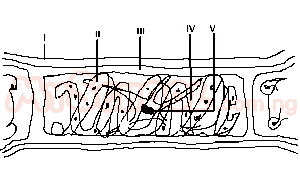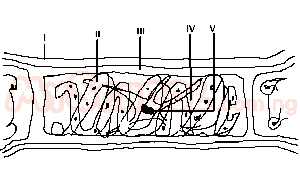Year :
1995
Title :
Biology
Exam :
JAMB Exam
Paper 1 | Objectives
1 - 10 of 50 Questions
| # | Question | Ans |
|---|---|---|
| 1. |
Which of the following does a virus have in common with animal cells? A. Nucleus B. DNA C. Gycogen D. Cytoplasm |
B |
| 2. |
Which of the following organelles are likely to be present in cells that are actively respiring and photosynthesizing? A. Nucleolus and centrioles B. Mitochondria and chloroplast C. Lysosomes and ribosomes D. Golgi apparatus and endoplasmic reticulum |
B |
| 3. |
One common characteristic of fungi, algae, mosses and ferns is that they A. show alternation of generations B. reproduce sexually by conjugation C. produce spores that are dispersed D. possess chlorophyll in their tissues |
C |
| 4. |
 Protein-like bodies are borne on the part labelled A. II B. III C. IV D. V |
A |
| 5. |
 The sexual reproductive function is performed by the part labelled A. I B. II C. IV D. V |
D |
| 6. |
Which of the following is transmitted through mosquito bite? A. Filariasis B. Typhus C. Plague D. Schistosomiasis |
A |
| 7. |
Which of the following insects lays its eggs in horny, purse-like cases? A. Mosquito B. Butterfly C. Termite D. Cockroach |
D |
| 8. |
Which of the following vertebrates does the skin function as a respiratory surface? A. Rat B. Lizard C. Fish D. Frog |
D |
| 9. |
Birds maintain their body temperature with the help of their A. blood which maintains constant temperature B. feathers which cover the body C. skin which conserves moisture D. veins which transport fluid of constant temperature to all body tissues |
B |
| 10. |
Secondary thickening in dicotyledonous stem is controlled by the A. xylem B. phloem C. cambium D. pericycle |
C |
| 1. |
Which of the following does a virus have in common with animal cells? A. Nucleus B. DNA C. Gycogen D. Cytoplasm |
B |
| 2. |
Which of the following organelles are likely to be present in cells that are actively respiring and photosynthesizing? A. Nucleolus and centrioles B. Mitochondria and chloroplast C. Lysosomes and ribosomes D. Golgi apparatus and endoplasmic reticulum |
B |
| 3. |
One common characteristic of fungi, algae, mosses and ferns is that they A. show alternation of generations B. reproduce sexually by conjugation C. produce spores that are dispersed D. possess chlorophyll in their tissues |
C |
| 4. |
 Protein-like bodies are borne on the part labelled A. II B. III C. IV D. V |
A |
| 5. |
 The sexual reproductive function is performed by the part labelled A. I B. II C. IV D. V |
D |
| 6. |
Which of the following is transmitted through mosquito bite? A. Filariasis B. Typhus C. Plague D. Schistosomiasis |
A |
| 7. |
Which of the following insects lays its eggs in horny, purse-like cases? A. Mosquito B. Butterfly C. Termite D. Cockroach |
D |
| 8. |
Which of the following vertebrates does the skin function as a respiratory surface? A. Rat B. Lizard C. Fish D. Frog |
D |
| 9. |
Birds maintain their body temperature with the help of their A. blood which maintains constant temperature B. feathers which cover the body C. skin which conserves moisture D. veins which transport fluid of constant temperature to all body tissues |
B |
| 10. |
Secondary thickening in dicotyledonous stem is controlled by the A. xylem B. phloem C. cambium D. pericycle |
C |